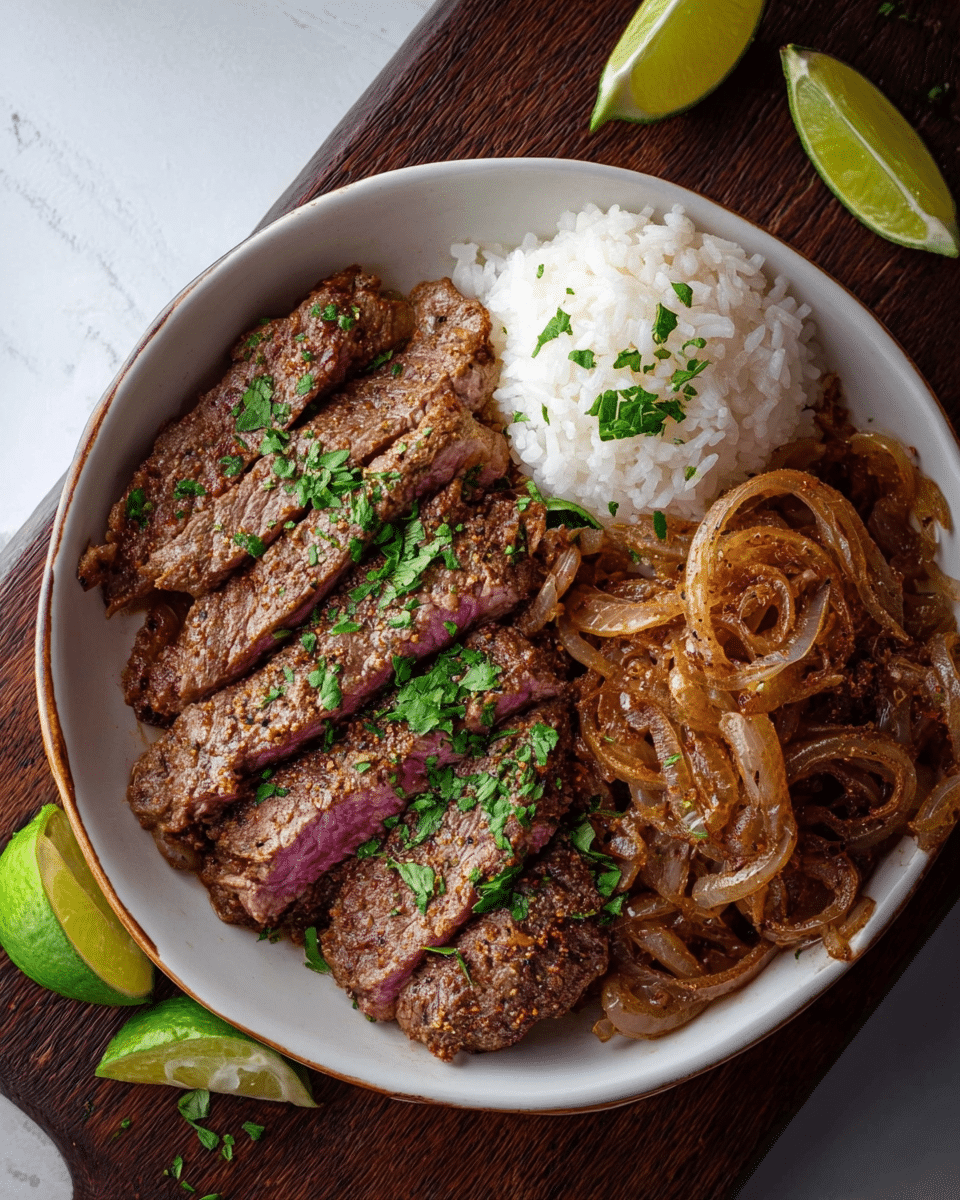The heart of Puerto Rican home cooking lies in comforting dishes like Bistec Encebollado. This savory dish combines thin slices of seasoned steak with sweet, caramelized onions in a flavorful blend of garlic, vinegar, and classic island spices like adobo and sazón. Simmered slowly to tender perfection, it’s a dish passed down through generations that warms both the belly and the soul.
Often served over a bed of fluffy white rice or alongside crispy tostones, this recipe is ideal for family dinners or when you simply crave a bite of the Caribbean. Easy to prepare and deeply satisfying, Bistec Encebollado delivers bold flavor with every forkful, celebrating the richness of Puerto Rico’s culinary heritage.
Full Recipe
Ingredients:
-
2 lbs thinly sliced beef round steak
-
2 large yellow onions, thinly sliced
-
1 tablespoon adobo seasoning
-
1 packet sazón with coriander and annatto
-
3 cloves garlic, minced
-
1/4 cup white vinegar
-
1/4 cup olive oil (plus more for cooking)
-
1/2 teaspoon dried oregano
-
1/4 teaspoon ground black pepper
-
1/4 teaspoon salt (optional, depending on adobo used)
-
1/2 cup water
Directions:
-
In a large bowl, season steak with adobo, sazón, garlic, vinegar, olive oil, oregano, black pepper, and salt (if needed). Massage the seasonings into the meat and marinate for at least 1 hour or overnight for best flavor.
-
In a large skillet, heat 1–2 tablespoons of olive oil over medium heat.
-
Sear the steak slices until browned on both sides (about 2–3 minutes per side). You may need to work in batches. Set aside once seared.
-
In the same skillet, add the sliced onions and sauté until they become soft and caramelized, about 8–10 minutes. Add a little more oil if needed.
-
Return the steak to the skillet with the onions. Add water and reduce heat to low. Cover and simmer for 20–30 minutes, allowing the flavors to meld and the steak to become tender.
-
Serve hot over white rice or with fried plantains.
Prep Time: 15 minutes | Cooking Time: 45 minutes | Total Time: 1 hour
Kcal: 390 kcal | Servings: 4 servings
The Cultural Significance of Bistec Encebollado
Bistec Encebollado is more than just a savory steak dish—it’s a culinary icon in Puerto Rican households. Deeply rooted in the island’s culture, it’s a meal that speaks to tradition, resilience, and comfort. For many Puerto Ricans, this dish evokes childhood memories of home-cooked dinners, abuelitas standing at the stove, and family meals shared around the kitchen table. It’s often considered a “weekday classic” due to its simplicity, affordability, and ability to feed a crowd.
The word “bistec” comes from the Spanish adaptation of the English word “beefsteak,” and “encebollado” literally means “with onions.” While the preparation may seem straightforward, every home has its own variation of the recipe—some passed down through generations, others adapted to suit modern ingredients and lifestyles. Regardless of the variation, the dish holds a nostalgic power that continues to bind generations of Puerto Ricans, whether they live on the island or abroad.
Origins and Evolution of the Dish
Though it is widely enjoyed across Latin America, Bistec Encebollado has a unique identity in Puerto Rican cuisine. Its roots go back to Spanish colonial influence, which introduced vinegar, olive oil, and garlic to the Caribbean pantry. These European staples merged with local and African traditions over time, resulting in a rich fusion of flavors. Puerto Rican cooks transformed this European-style steak into something uniquely Caribbean by incorporating native seasonings like adobo and sazón.
Originally a practical way to prepare tougher cuts of beef, the method of marinating and slow-cooking allowed even the leanest meat to become tender and flavorful. Over time, this dish became a symbol of culinary ingenuity—proof that with the right technique and seasoning, humble ingredients could become something truly special.
Why It’s a Beloved Comfort Food
There’s something deeply satisfying about a hot plate of Bistec Encebollado. The hearty steak, when simmered with sweet caramelized onions, becomes melt-in-your-mouth tender and rich in flavor. The vinegar cuts through the fattiness of the meat while the garlic and sazón infuse it with warmth and spice. It’s savory, tangy, and aromatic all at once.
What elevates the dish to comfort-food status is how it pairs perfectly with staples like white rice, mofongo, or tostones. The onions create a natural gravy that seeps into the rice, turning every bite into a burst of flavor. Add a side of avocado or a fried egg, and you’ve got a complete, soul-soothing meal.
Tips for Making It Perfect Every Time
Making Bistec Encebollado at home is both accessible and rewarding. However, a few techniques can take your version from good to truly exceptional.
1. Choose the right cut: Thinly sliced top round or sirloin is ideal. While the dish is traditionally made with tougher cuts, modern cooking allows you to experiment with higher-quality beef for more tenderness.
2. Marinate for flavor: Don’t rush the marinade. Letting the steak sit for at least an hour (or preferably overnight) helps the seasonings penetrate and tenderize the meat.
3. Don’t skimp on the onions: This dish is as much about the onions as it is about the steak. Slice them thinly and caramelize them slowly to build a deep, sweet flavor base.
4. Use the right pan: A heavy-bottomed skillet or cast iron pan helps sear the steak properly and withstands long simmering without burning the onions or sauce.
5. Let it simmer: The magic of this dish comes in the simmering process. Once the meat is browned and the onions are sautéed, a gentle simmer brings everything together and allows the sauce to thicken and coat the beef.
Pairings and Serving Suggestions
Bistec Encebollado is incredibly versatile when it comes to sides. Its bold flavor makes it a centerpiece dish that works well with many traditional Puerto Rican accompaniments. The most common pairing is white rice, which absorbs the juices and provides a neutral base to balance the intense flavor of the beef and onions.
For a heartier meal, serve it with arroz con gandules (rice with pigeon peas) or arroz mamposteao (a seasoned mix of rice and beans). Tostones (fried green plantains) offer a crispy contrast, while amarillos (sweet fried plantains) add a touch of sweetness that pairs beautifully with the vinegar in the steak.
For drinks, consider a simple agua fresca, coconut water, or a light beer. For a special occasion, pair it with a glass of red wine or a Puerto Rican cocktail like a coquito or piña colada.
Common Variations Across Households
Every Puerto Rican family has their own twist on Bistec Encebollado. Some add bell peppers for sweetness and color, while others toss in green olives for a briny kick. A few households thicken the sauce with tomato paste or add a splash of beer or red wine to enrich the flavor.
Some cooks swap out beef for pork or chicken, especially when catering to different dietary needs or preferences. While purists might scoff at these changes, it’s a testament to the adaptability of the dish that it can be reimagined while still honoring the traditional flavor profile.
Modern Takes and Healthier Alternatives
For those looking to make this dish a bit lighter or more health-conscious, there are plenty of options. Use leaner cuts of beef, reduce the oil, or opt for a low-sodium adobo and sazón without MSG. Serving it over cauliflower rice or alongside roasted vegetables turns this traditional comfort food into a balanced meal that fits into a healthy lifestyle.
Vegetarian versions are also on the rise. Many home cooks now prepare “Bistec Encebollado” using portobello mushrooms, jackfruit, or even tofu to mimic the steak’s texture while absorbing the same marinade. Though non-traditional, these adaptations speak to the dish’s broad appeal and evolving role in modern kitchens.
Bistec Encebollado in Diaspora Communities
For Puerto Ricans living outside of the island, especially in places like New York, Florida, or Chicago, Bistec Encebollado is a taste of home. It’s one of those go-to dishes that bridges generations and geography. Whether you’re shopping at a Latin market in the Bronx or cooking in a college dorm in California, the smell of onions and garlic sizzling in olive oil is instantly comforting.
In diaspora communities, this dish serves not only as a meal but as a cultural anchor. It’s a dish people teach their kids, share at family reunions, and pass on in handwritten recipe books. It’s a way of preserving identity in a foreign land.
Why You Should Try This Dish
If you’ve never made Bistec Encebollado before, now is the perfect time to start. It’s a recipe that’s simple enough for beginners, but rich and complex enough to impress even the most seasoned food lovers. It doesn’t require exotic ingredients or advanced techniques, yet it delivers a deeply satisfying result every time.
This dish allows you to explore Puerto Rican culture through taste, and it might just become a regular on your weekly dinner menu. It’s ideal for family meals, weekend gatherings, or quiet nights when you crave something hearty and homemade.
Conclusion: A Dish That Tells a Story
Bistec Encebollado is more than just steak and onions—it’s a dish that tells a story. It’s about heritage, love, and ingenuity in the kitchen. It’s about making the most of what you have and transforming it into something special through technique, time, and tradition.
Whether you’re Puerto Rican by blood, by marriage, or simply by appetite, this dish invites you to slow down, savor your meal, and connect with something deeper. In every bite, you taste history, family, and the vibrant flavors of the island.
So next time you’re thinking about what to cook for dinner, consider Bistec Encebollado. Not just for the flavor, but for the story it brings to your table.






